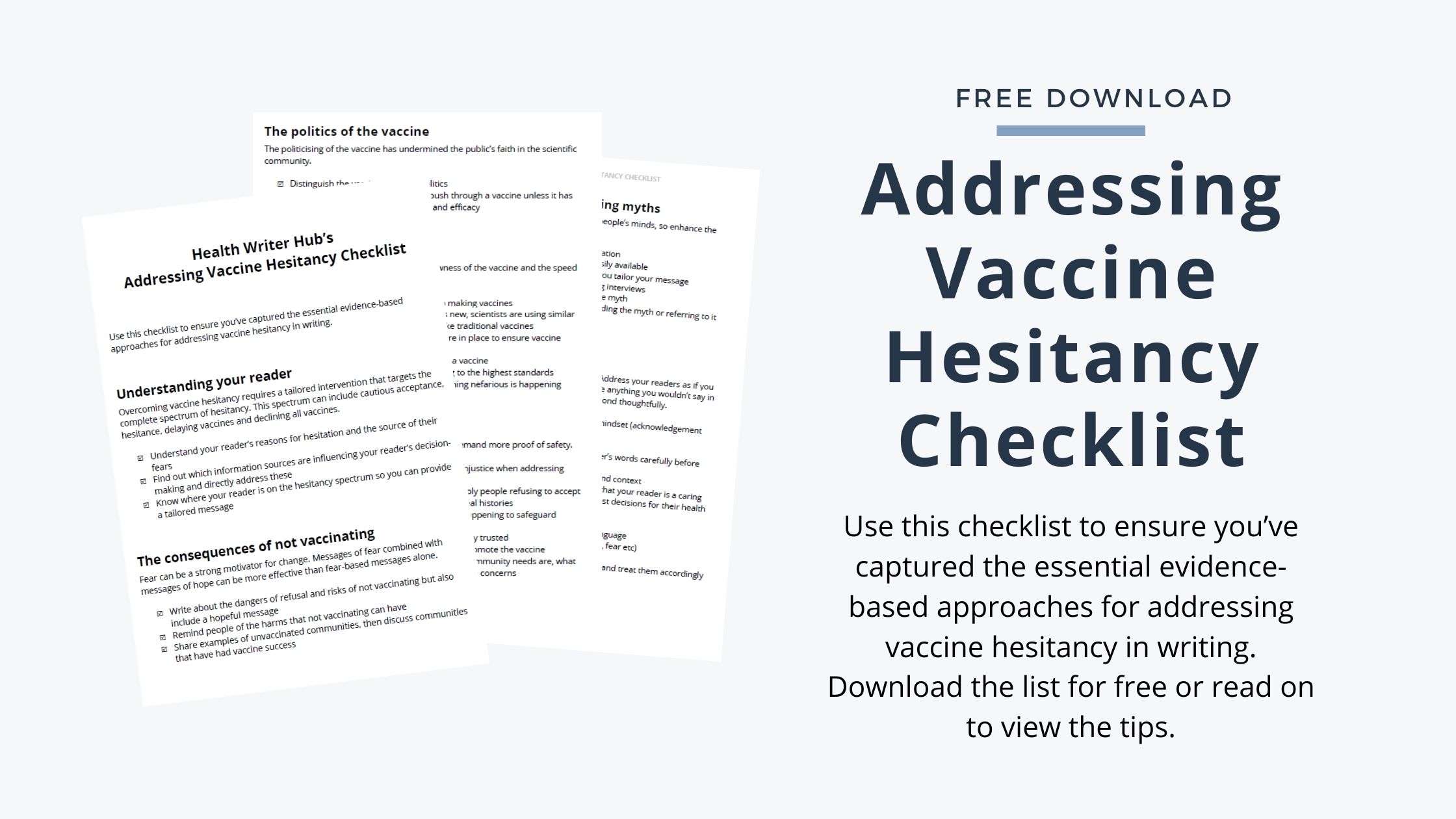
Addressing Vaccine Hesitancy Checklist
The tips in this checklist come from our articles on evidence-based vaccine hesitancy and COVID-19 vaccine hesitancy, and how COVID-19 has changed vaccine hesitancy. Use these tips when you’re writing patient education material, articles or health blogs. You can also view our post on how to write clearly about COVID-19 for more tips.
Understanding your reader
Overcoming vaccine hesitancy requires a tailored intervention that targets the complete spectrum of hesitancy. This spectrum can include cautious acceptance, hesitance, delaying vaccines and declining all vaccines.
- Understand your reader’s reasons for hesitation and the source of their fears
- Find out which information sources are influencing your reader’s decision-making and directly address these
- Know where your reader is on the hesitancy spectrum so you can provide a tailored message
The consequences of not vaccinating
Fear can be a strong motivator for change. Messages of fear combined with messages of hope can be more effective than fear-based messages alone.
- Write about the dangers of refusal and risks of not vaccinating but also include a hopeful message
- Remind people of the harms that not vaccinating can have
- Share examples of unvaccinated communities, then discuss communities that have had vaccine success
The politics of the vaccine
The politicising of the vaccine has undermined the public’s faith in the scientific community.
- Distinguish the vaccine from the politics
- Reinforce that scientists would not push through a vaccine unless it has met the highest standards of safety and efficacy
Newness hesitations
Address specific concerns relating to the newness of the vaccine and the speed at which it came to market.
- Highlight the consistency that goes into making vaccines
- Explain that, even though this vaccine is new, scientists are using similar mechanisms as they have before to make traditional vaccines
- Emphasise the rigorous protocols that are in place to ensure vaccine safety
- Discuss the increased scrutiny regarding a vaccine
- Stress that the new vaccines are adhering to the highest standards
- Explain that everyone is watching, so nothing nefarious is happening
Racial injustice
Past hurt makes people more likely to doubt or demand more proof of safety.
- Be understanding and empathetic of racial injustice when addressing vaccine hesitancy concerns
- Acknowledge that vaccine hesitancy isn’t simply people refusing to accept science; sometimes it’s rooted in incredibly real histories
- Acknowledge past hurt and explain what is happening to safeguard communities now
- Speak with community leaders who are already trusted
- Include community leaders when writing to promote the vaccine
- Talk to community leaders about what their community needs are, what the key concerns are and how to alleviate these concerns
Misinformation and debunking myths
Debunking alone is not effective in changing people’s minds, so enhance the message by sharing correct information.
- Continue to promote the correct information
- Make correct information widely and easily available
- Be aware of unconscious bias and how you tailor your message
- Ask unbiased questions when conducting interviews
- Focus on the correct message and not the myth
- Share accurate information without including the myth or referring to it subtly or explicitly
Communicating with courtesy
All messages must be empathetic and sensitive. Address your readers as if you are having a face-to-face conversation. Don’t write anything you wouldn’t say in person. Listen to your reader’s concerns and respond thoughtfully.
- Acknowledge the reader’s fears, beliefs or mindset (acknowledgement doesn’t mean you agree with them)
- Communicate with empathetic language
- If responding to comments: Read your reader’s words carefully before sharing your perspective
- Use a suitable tone for the target audience and context
- Explicitly mention and acknowledge the fact that your reader is a caring parent or citizen who is trying to make the best decisions for their health and/or their families’ health
- Stay calm during the writing process
- Don’t use negative, demeaning or insulting language
- Focus on the category of the argument (safety, fear etc)
- Provide the evidence with respect
- Remember that your reader is a human being and treat them accordingly
Personal stories
Personal stories are more powerful and convincing when they’re about one person, not many people.
- Share stories from someone who has changed their mind about vaccination
- Share stories from frontline workers who took the vaccine
- Share stories from members of the public who took the vaccine
Writing in plain English and accessibility
Incorporating the key principles of plain English makes your writing easy to scan, read, understand and remember.
- Use common, everyday words that are less than four syllables
- Avoid or define complex medical terms, abbreviations and acronyms
- Include pronunciation of unfamiliar words
- Use positive statements and language, not negative language (focus on what can be done, not what can’t be done)
- Use conversational language (write how you talk)
- Use the active voice where possible
- Make sure your sentences are 1-2 lines, with different lengths
- Use short paragraphs (no more than 4-5 lines)
- Use whole numbers instead of decimals
- Don’t make your readers calculate (add, subtract, multiply or divide)
- Express risk information in frequencies (1 out of 10 instead of 10%)
- Use a readability tool, but be aware of its limitations
- Use a structure that is logical and easy to follow
- Include the main point and most important information at the beginning
- Use subheadings to provide a guide/roadmap to the content
